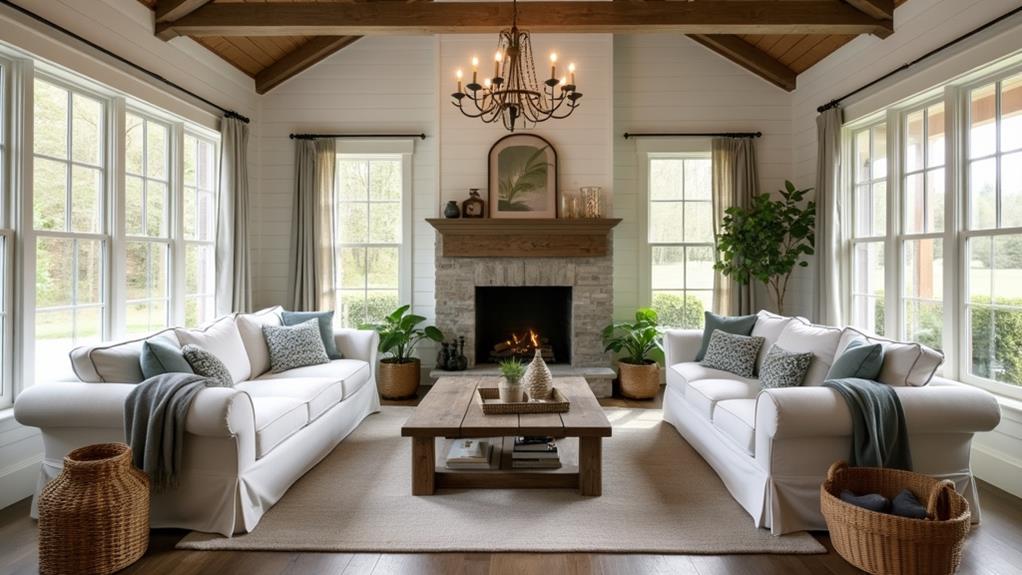Today's trendy farmhouse living rooms balance comfort with authenticity by integrating rustic elements and vintage charm. They focus on natural materials like wood, stone, and metals, highlighted in a neutral color palette of whites, creams, and grays. Furniture is functional, sturdy and vintage-inspired. Remember, the goal is creating spaces ideal for family socializing and relaxation. Infusing your space with repurposed items and cozy textiles can also up its comfort quotient while retaining that rustic allure. But this is just scratching the surface. There's a treasure trove of design tips and tricks waiting for you, all ensuring your living room exudes that cozy farmhouse vibe.
Understanding the Farmhouse Style
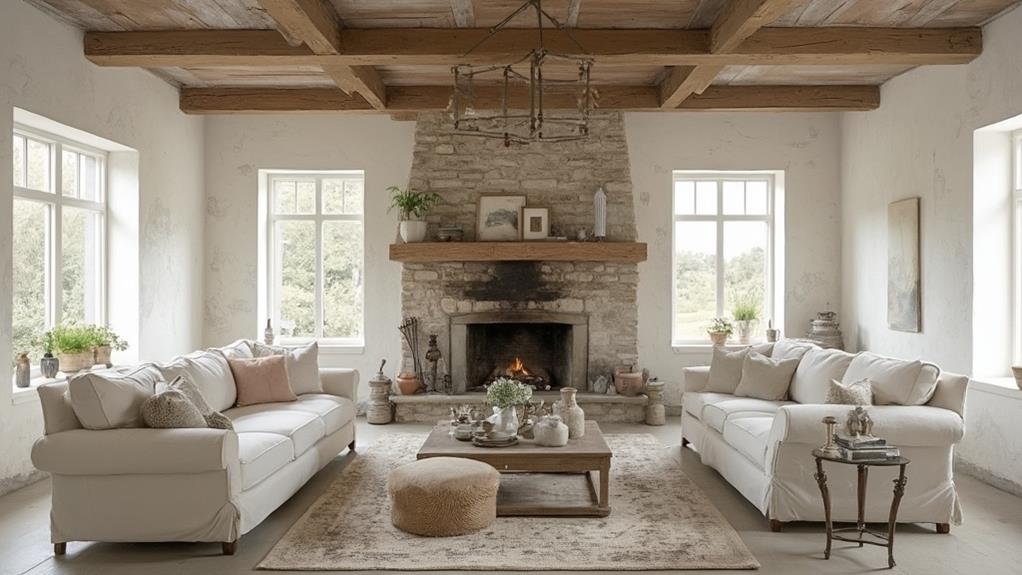
Diving right into the heart of farmhouse style, you'll find that it's all about comfort and practicality.
It's a style that emphasizes warm, cozy living spaces designed for real-life families, not just for show. It's a design trend that cherishes the beauty of imperfection.
You'll see lots of natural materials in a farmhouse-style home, like reclaimed wood, cotton, linen, and wool.
These materials help create a relaxed, lived-in vibe that's so characteristic of the style. At its core, the farmhouse style celebrates simplicity and authenticity.
It's not about having the latest, most expensive pieces, but about creating a space that feels like home.
The color palette tends to lean towards neutrals, but that doesn't mean it's boring.
You'll find plenty of texture and depth in the mix of materials and finishes.
And while the farmhouse style has its roots in rural living, it's not limited to country homes.
You can incorporate elements of this style into any space, whether you're in the city, the suburbs, or the countryside.
Key Elements of Farmhouse Style

There are several key elements that distinguish the farmhouse style from others. You'll likely notice the dominance of natural textures and materials. Think wood, stone, and metal; these elements form the backbone of farmhouse decor. They're often left in their raw, unpolished state, exuding a sense of honesty and simplicity.
Next, you'll see an abundance of neutral colors. The farmhouse palette is typically soft and muted, with plenty of whites, creams, and grays. This creates a serene, welcoming atmosphere that's a hallmark of the style. But don't think it's all about subtlety; pops of color are often introduced through accessories like pillows and rugs.
Farmhouse style also embraces practicality. Furniture pieces are sturdy and functional, often with a touch of vintage charm. You won't find too much ornamentation here, but rather an appreciation for the beauty found in functionality.
Lastly, farmhouse living rooms are all about comfort. Plush seating, cozy throws, and warm lighting are key. The aim is to create a space that invites you to kick back, relax, and enjoy the simple things in life. That's the essence of farmhouse style.
Incorporating Rustic Elements
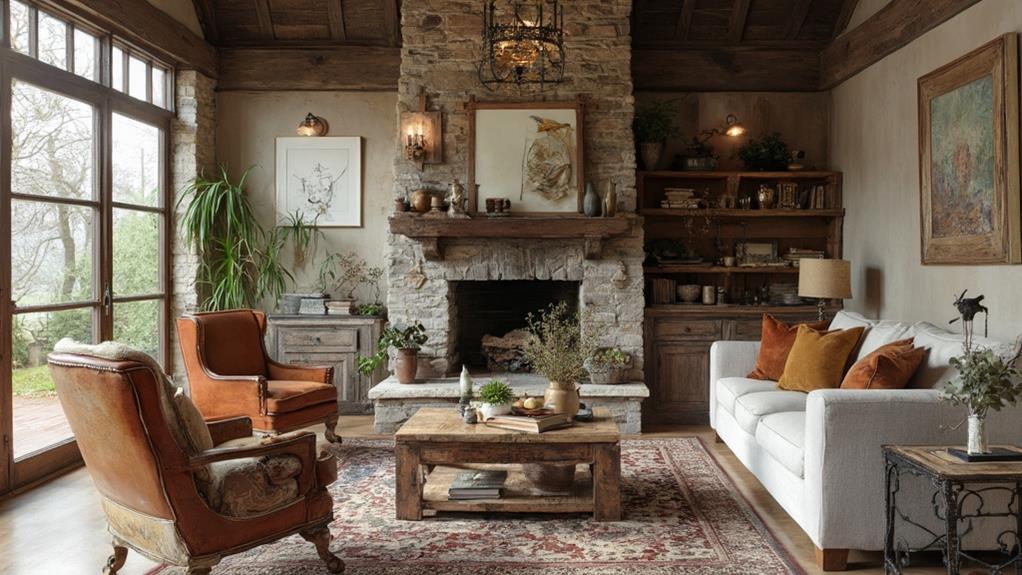
One of the most effective ways to incorporate rustic elements into your farmhouse living room is by using repurposed items. Old barn doors, wooden crates, and antique farming tools can add a touch of authenticity to your space. They don't just serve an aesthetic purpose; they can also double as practical storage solutions.
For instance, you can use a barn door as a unique coffee table or rustic wall decor. Wooden crates can be stacked to create a one-of-a-kind bookshelf. An old ladder can be repurposed as a quirky display for your blankets and throws. These items aren't just charming; they're a reflection of your commitment to sustainability.
Natural materials like wood and stone are also key. Consider a stone fireplace or a reclaimed wood accent wall. These elements will give your living room a warm, earthy feel that's perfect for a farmhouse aesthetic.
Don't forget about textiles, either. Burlap, linen, and wool throw pillows and rugs can add depth and texture to your living room. They'll not just keep you cozy; they'll also complete your rustic farmhouse look.
Choosing a Neutral Color Palette
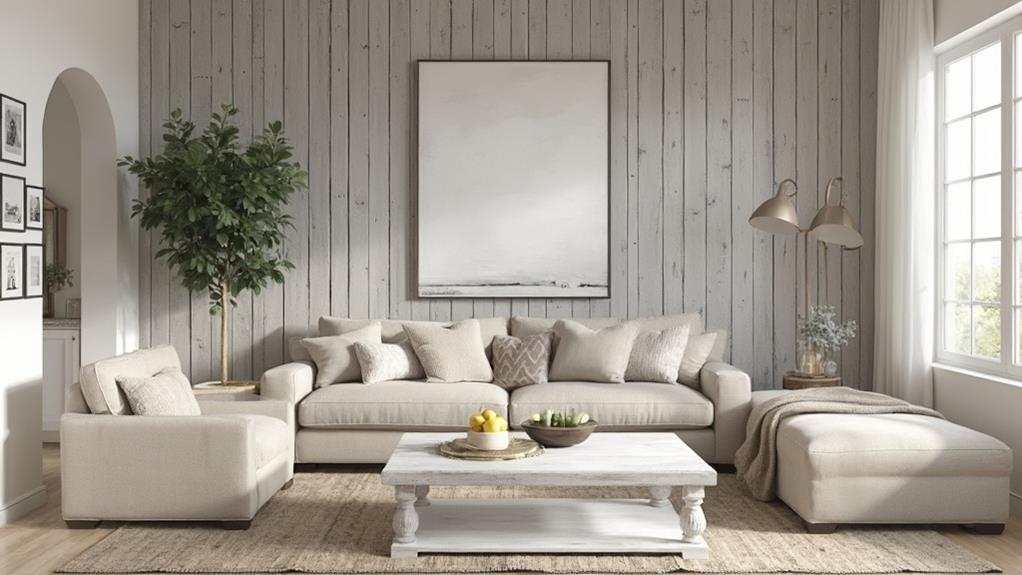
A neutral color palette is at the heart of any farmhouse living room design. It's the canvas upon which you'll paint your personal touches. Neutrals don't have to be boring; instead, they provide a soothing background that allows your favorite pieces to shine.
Choosing the right neutrals isn't as easy as picking white or beige. There's a whole spectrum of inviting shades that can add depth and interest to your room. Consider these factors:
- Warm or Cool: Decide if you're going for a warm or cool vibe. Warm neutrals include tans, beiges, and soft yellows, while cool neutrals feature grays, blues, and greens.
- Lighting: Judge how much natural light your room gets. Lighter shades work best in darker rooms, while darker neutrals can create a cozy feel in a well-lit room.
- Furnishings: Match your neutral to the major pieces of furniture in your room. This creates a cohesive look.
- Mood: Think about the mood you want to set. Soft, light neutrals create a serene vibe, while darker shades can feel more dramatic.
Using Natural Materials in Design
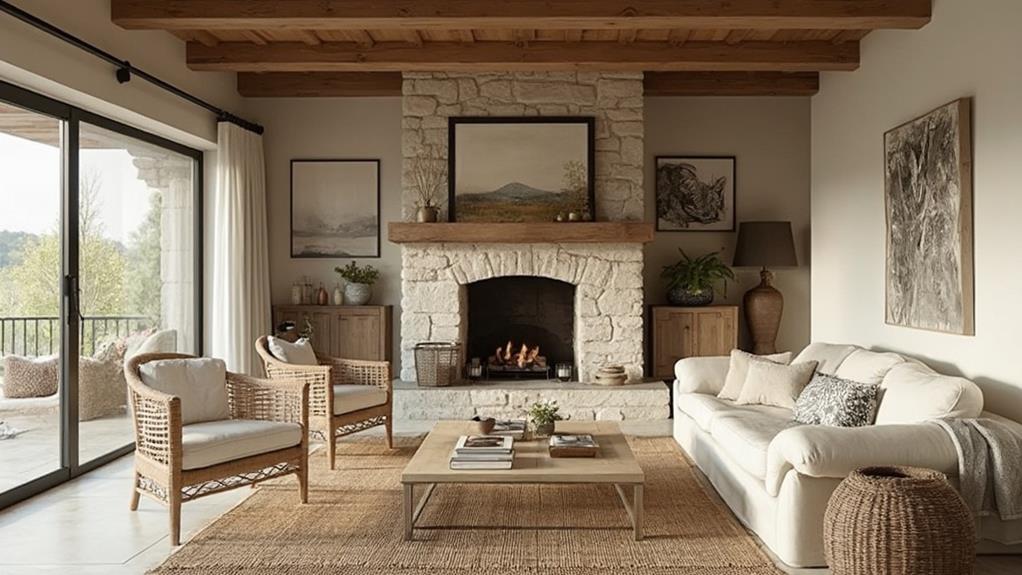
Moving from color to texture, your choice of materials plays a significant role in creating an authentic farmhouse feel. Natural materials are the backbone of this style, bringing in warmth, texture, and a tactile quality that can't be replicated with synthetic alternatives. Think wood, stone, wool, and linen.
Wood is an absolute must. It's versatile, grounding, and rich in character. Use it for flooring, beamed ceilings, or rustic furniture pieces.
Stone, whether as a fireplace surround or exposed brick wall, adds a rugged, earthy element. Incorporating wool in rugs or throws, and linen in curtains or bedding brings in a soft, cozy layer.
In your quest for natural materials, don't overlook metal. Iron, copper, or brass can add a touch of industrial farmhouse charm. Remember, it's all about balance. Too much of one material can overwhelm, so mix and match to create a harmonious blend.
Lastly, bring the outside in with plants. They add color, texture, and a breath of new life.
Selecting Vintage Furniture Pieces
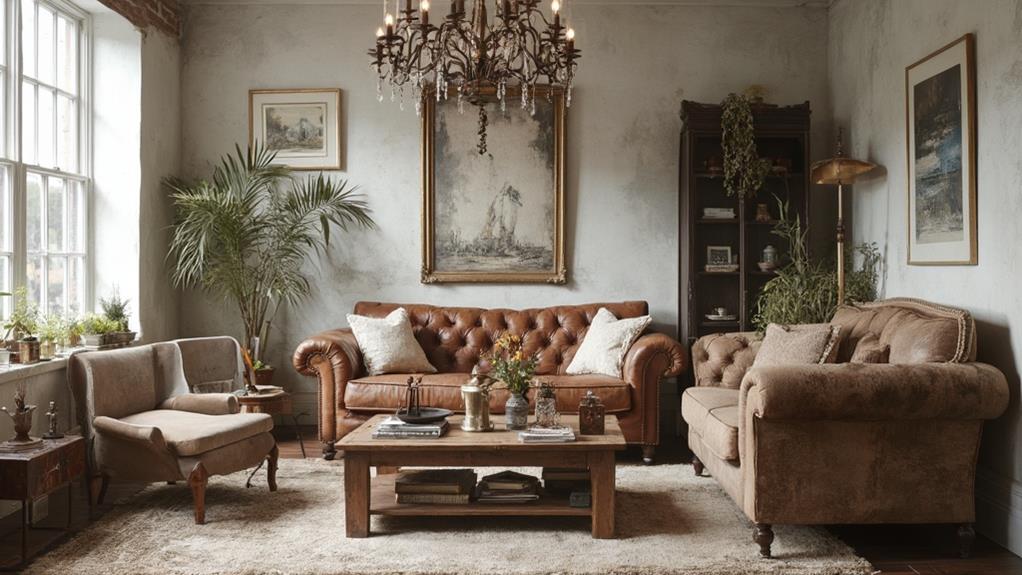
When it comes to creating an authentic farmhouse look, selecting the right vintage furniture pieces is essential. They add character, warmth, and a sense of history.
But don't feel you've got to scour antique shops or flea markets. Today's reproduction pieces can evoke the same rustic charm.
Here's a simple guide to get you started:
- Wooden tables: Look for chunky, worn-in pieces that scream durability. A weathered oak dining table or a distressed coffee table can anchor your room.
- Upholstered chairs: Opt for neutral toned chairs with vintage-inspired fabrics like ticking stripes or grain sack.
- Accent pieces: An old wooden bench, a vintage ladder, or a metal milk jug can add that farmhouse touch. Don't be afraid to repurpose items.
- Storage: Think rustic wooden crates, wicker baskets, or metal bins. They're not only practical but also add to the farmhouse aesthetic.
Creating an Open Floor Plan

To achieve that open, airy feel typical of farmhouse living rooms, consider creating an open floor plan. It's a simple trick that works wonders. By knocking down unnecessary walls, you're not only creating a spacious environment but also inviting more natural light into your space.
An open floor plan promotes conversation and interaction between family members and guests, making it perfect for social gatherings. It's also very flexible and adaptable to any changes you might want to make in the future. For example, you could easily incorporate new elements like coordinating rugs or statement furniture to enhance the overall look.
In the open floor plan, the kitchen, dining room, and living room all flow into one another. This layout allows for an easy shift from one area to another, creating a cohesive and harmonious look.
Don't fret about the furnishing yet. The furniture arrangement will follow the openness of your space. You'll have to be smart about your choices, though. Consider furniture that's both functional and aesthetically pleasing.
Adding Cozy Textiles for Comfort
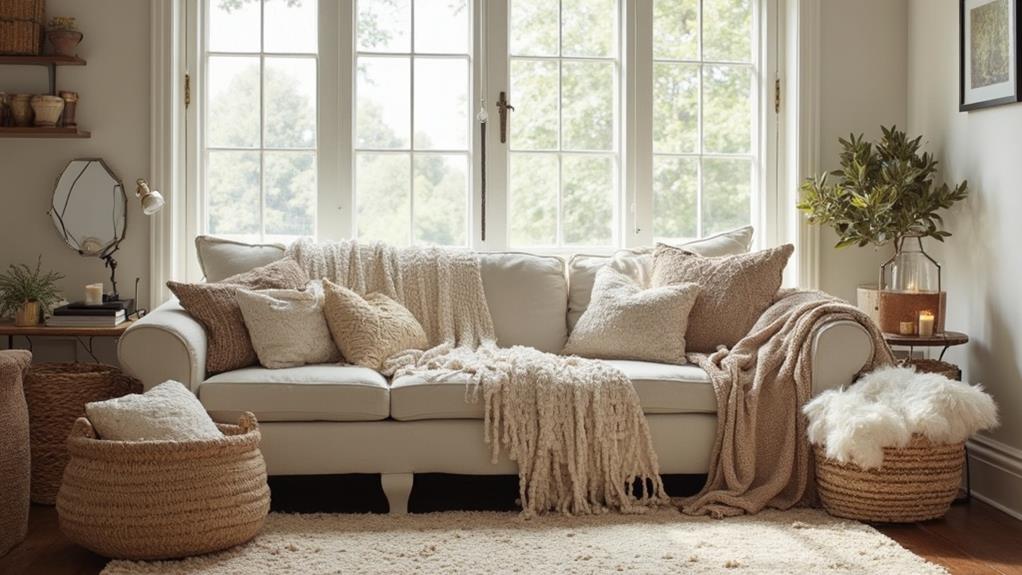
After choosing the perfect open floor plan, it's time to add character and warmth to your farmhouse living room with cozy textiles.
These textiles aren't just about aesthetics; they're about comfort, too. Imagine curling up on a chilly night wrapped in a soft blanket or sinking your toes into a plush area rug. That's the kind of comfort cozy textiles can provide.
When adding textiles, don't be afraid to mix and match. Find the balance between comfort and style that suits your personal taste. Here are some suggestions to get you started:
- Throw blankets: Drape these over your couch or armchair for an instant cozy vibe.
- Area rugs: These not only add visual interest but also provide a soft space for your feet.
- Pillows: Don't skimp on these – they can transform a sofa from good to great.
- Curtains: Opt for heavier fabrics for a homier feel and added privacy.
Styling Tips: Merging Traditional With Modern

In the domain of farmhouse living rooms, blending traditional elements with modern flair might seem challenging, but it's far from impossible. Here, the key is to strike a balance that pays homage to rustic charm while still embracing contemporary aesthetics.
Start by selecting classic pieces, like a large farmhouse table or a vintage-style sofa, as your room's anchor points. These items will lend an unmistakable country feel to your space. You can then use modern elements, such as sleek lighting fixtures or minimalist art, to add a contemporary twist.
Don't be afraid to mix materials and textures. Pair a weathered wooden table with polished metal chairs for a pleasing contrast. Incorporate cozy textiles like woven rugs and chunky knits to soften the look.
Remember, color plays an essential role. Opt for a palette that combines warm neutrals of a traditional farmhouse with more vibrant hues for a modern touch. Think creamy whites and soft greys with pops of yellow or teal.
Lastly, personal touches make a room truly yours. Display cherished family photos or your favorite books to add personality. It's your space – make it feel like home.
Executing Your Farmhouse Makeover

Before diving headfirst into your farmhouse makeover, it's essential to have a solid plan in place. Start by visualizing your dream space. What elements of farmhouse style appeal to you the most? Remember, it's your home; don't be afraid to put your personal stamp on it.
Here's a simple four-step guide to help you execute your farmhouse makeover smoothly:
- Identify key elements: Farmhouse style is about comfort and simplicity. Look for rustic furniture, vintage décor, and natural textures.
- Plan your layout: Consider how your space can best accommodate these elements. Remember, balance and harmony are key.
- Set a budget: Farmhouse style can be achieved on a shoestring or a splurge. Know your limits and stick to them.
- Implement step-by-step: Don't rush. Tackle one area at a time to avoid getting overwhelmed.

